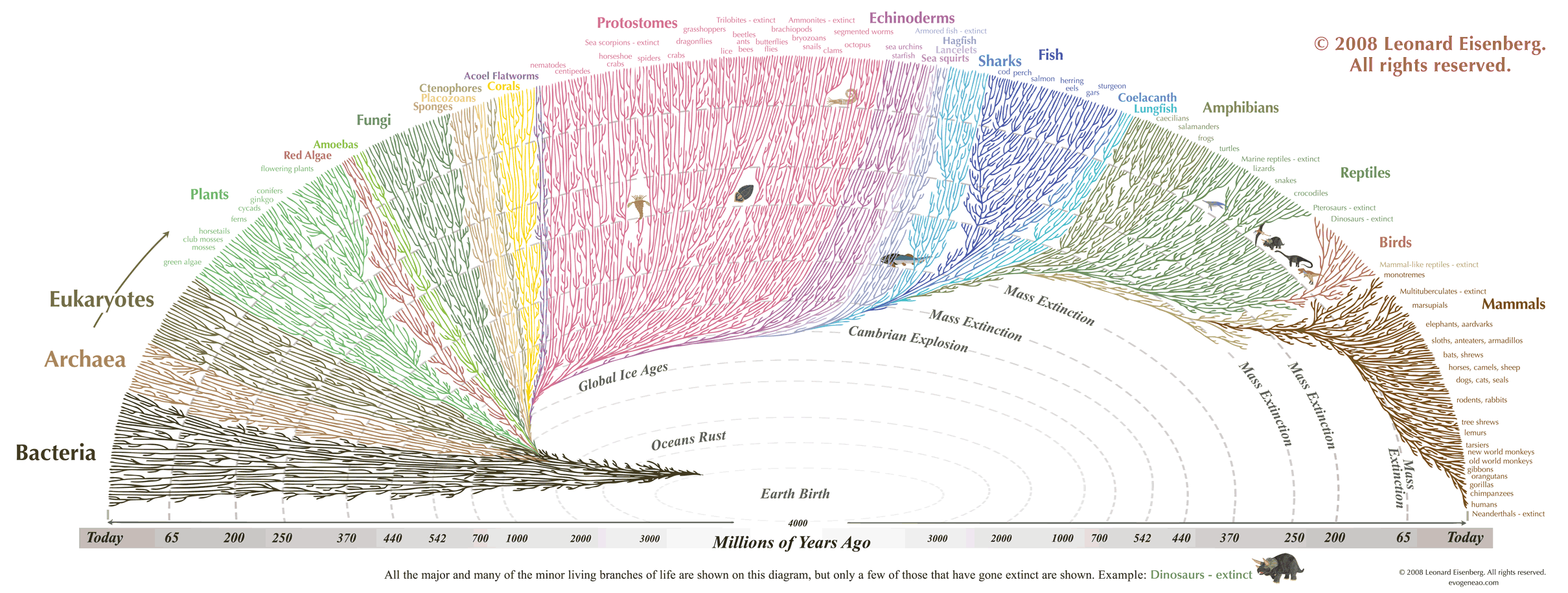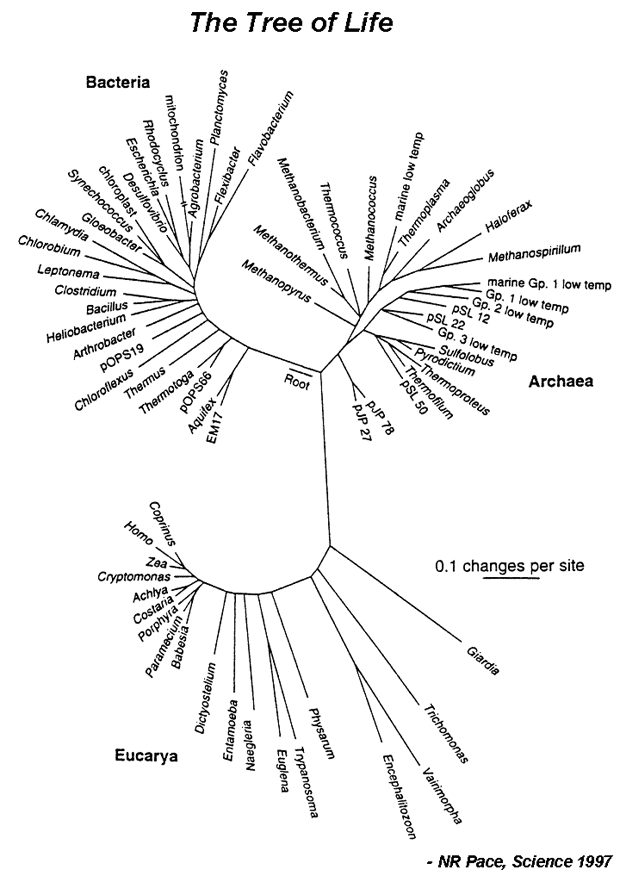Qubi/biol200
Objective
- To classify microorganisms and determine their relatedness using molecular sequences.
Lab Report Grading Policy
- Introduction (1pt)
- Statement of objectives or aims of the experiment in the student’s own words. This is not to be copied from the Lab Manual.
- Materials and Methods (0pts)
- This should be a brief synopsis and must include any changes or deviations from the procedures outlined in the Lab Manual. Specify which organisms were used to create the phylogram.
- Results (4pts)
- A print out of the phylogram will suffice.
- Discussion (4pts)
- Answer discussion questions.
- Summary/Conclusion (1pt)
- A sentence or two will suffice
- References (1pt)
- Credit is given for pertinent references obtained from sources other than the Lab Manual. This point is in addition to the 10 for the lab report.
Introduction
Evolution can be defined as descent with modification. In other words, changes in the nucleotide sequence of an organsim’s genomic DNA is inherited by the next generation. According to this, all organisms are related through descent from an ancestor that lived in the distant past. Since that time, about 4 billion years ago, life has undergone an extensive process of change as new kinds of organisms arose from other kinds existing in the past.
The evolutionary history of a group is called a phylogeny, and can be represented by a phylogram [Figure 1]. A major goal of evolutionary analysis is to understand this history. We do not have direct knowledge of the path of evolution, as by definition, extinct organisms no longer exist. Therefore, phylogeny must be inferred indirectly. Originally, evolutionary analysis was based upon the organisms’ morphology and metabolism. This is the basis for the Linnaean classification scheme (the “Five Kingdoms” scheme). However, this method can lead to mistaken relationships. Different species living in the same environment may have similar morphologies in order to deal with specific environmental factors. Thus these similarities have nothing to do with how related the organisms are, but are a direct result of shared surroundings. However, with the advent of genomics, organisms can be grouped based upon their sequence relatedness. Since evolution is a process of inherited nucleotide change, analyzing DNA sequence differences allows for the reconstruction of a better phylogenetic history.
Of course, when comparing DNA sequences, the question of which genes to use arises. The most widely used genes are those coding for the 16S rRNA gene in prokaryotes and the 18S rRNA gene in eukaryotes. These genes code for small subunit ribosomal RNA and are used for evolutionary analysis because they 1) are found in all organisms, 2) are functionally conserved, 3) vary only slightly between organisms (their nucleotide sequence changed slowly throughout evolution), and 4) have adequate length. In this lab, you will be performing evolutionary analysis by constructing a phylogram of 15 microbes spanning bacteria, archaea and eukarya. You will find and download rRNA sequences, align them and use that alignment to create a phylogram.
Procedures
Materials: Computer
- Examine Table I, select representative species from Bergey’s Manual. Select 2 prokaryotic species from each group, giving 14 prokaryotic species total. Also select the Eukaryotic representative, Saccharomyces cerevisiae.
- Access the NCBI website: http://www.ncbi.nlm.nih.gov/
- Under the “Search” category, select “Nucleotide”.
- Under the “for” category, type the accession number for your first organism, and hit the “Go” button. This takes you to the access for the 16S rRNA for your organism.
- Download the 16S rRNA sequence for your first organisms by choosing “FASTA” under the “Display” category.
- Copy and paste the entire output into a Microsoft Word file.
- Edit the sequence id to match the format of “Genus_Species_Genbank#” (eg. > Escherichia_coli_174375).
- Repeat process for all of your organisms, pasting the sequences into the same Microsoft Word file. *Note: Be sure to place a blank line between each sequence entry.
- Access the EMBL CLUSTALW alignment website: http://www.ebi.ac.uk/Tools/clustalw/, and copy and paste your entire Microsoft Word file into the area which asks you to “Enter or paste a set of sequences in any supported format”. Click “Run”. This program will make an alignment of all of your sequences..
- Click “Show as Phylogram Tree” to create a tree showing the relatedness of your organisms based on their 16S rRNA sequences.
- To print your phylogram tree:
- a) hit the “Print Screen” button on your keyboard
- b) open the Paint program from your “accessories” menu on your computer
- c) hit "paste" to paste your screen
- d) “select” your phylogram tree
- e) copy and paste it into a new paint file
- f) print your tree and email it to yourself.
Discussion Questions
- Answer the following questions based on a Tree of Life shown in Figure 1:
- a) What do internal and terminal nodes represent?
- b) What do branch lengths represent? What’s the unit and meaning of the scale bar?
- c) Identify the positions of Humans (Homo), corn (Zea), E.coli, and Bacillus on the tree. Use the scale bar to estimate which pair is evolutionarily more distant: human/corn or E.coli/Bacillus?
- In Figure 2, which two species are more closely related: 1 and 2, 2 and 3, or 1 and 4? Which are more distantly related? How did you determine this?
- In Figure 2, is 1 more, less, or equally related to 4 and 5? Explain your rationale.
- List and describe the key steps of constructing a phylogenetic tree.
- Why do we use 18S rRNA information for yeast and 16S for prokaryotes? Could we use other molecules as phylogenetic markers? What constitutes a “good” phylogenetic marker for building a tree of life?
Bonus Question
- Define 16S “phylo-species” and “metagenomics”. Describe how PCR amplification and sequencing of 16S rRNA molecules from environmental microbial samples (e.g., sea water, soil, human gut, hot springs) can be used to define species composition of an environment.
References
- Jungck, J. R.; Fass, M.F.; Stanley, E. D. (ed.). 2003 (2006 Revision). Microbes Count! Problem Posing, Problem Solving, and Peer Persuasion in Microbiology. BioQUEST Curriculum Consortium. (Chapter 6, pg 191)
- Holt. J. G. Editor-in-Chief (1984). Bergey’s Manual of Systematic Bacteriology, Volume 1-4. Williams & Wilkins: Baltimore. http://www.cme.msu.edu/bergeys/pubinfo.html

